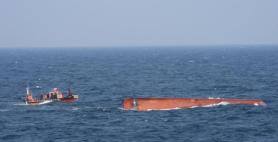
The primary culprit is Nomura's jellyfish, one of the largest jellyfish species in the world, capable of growing up to two meters (6.5 feet) long and weighing as much as 200 kilograms (440 pounds). These jellyfish, typically found across East Asia, have been spotted in alarming numbers this year along the coastlines of the Korean Peninsula.
Jellyfish thrive in warmer waters, and the record-high sea temperatures this summer have created ideal conditions for their proliferation. Fishermen, frustrated by the growing numbers, often tear apart the jellyfish they catch, but this approach only worsens the situation. Nomura's jellyfish, when threatened, release all their eggs and sperm, rapidly increasing their population.
Data from the National Institute of Fisheries Science under the ministry reveals that the density of Nomura's jellyfish in Korean waters this year has reached 108 per hectare (10,000 square meters) -- the highest since monitoring began in 2015. In comparison, past observations recorded an average of 20 to 40 jellyfish per hectare, with last year's numbers as low as 0.3 per hectare.
The venom of Nomura's jellyfish is highly toxic. A single sting can cause severe symptoms, including swelling, fever, muscle paralysis, difficulty breathing, and even shock.
The presence of these jellyfish has contributed to a decline in beachgoers, with around 37.97 million people visiting beaches between late June and mid-August this year, down from 39.84 million in 2022. The southern and eastern regions, where these jellyfish are most common, have seen a particularly sharp decline in visitors - down 23 percent from two years ago to 20.86 million this year.
Fishermen are also suffering from their sudden rise. The heavy weight of the jellyfish often breaks fishing nets, and the mucus they secrete can ruin the nets and spoil the catch, rendering the nets unusable.
The ministry attributes the surge in jellyfish numbers to rising sea temperatures, which have led to a significant increase in plankton -- the jellyfish's primary food source.
Copyright ⓒ Aju Press All rights reserved.




